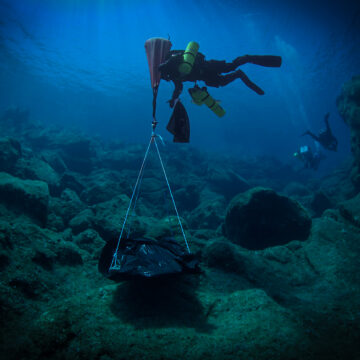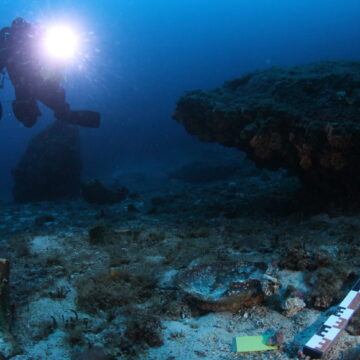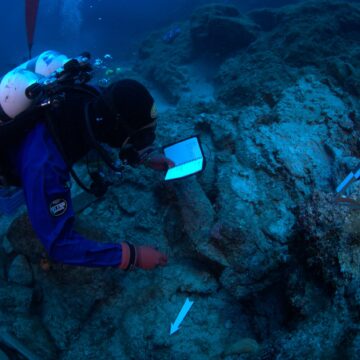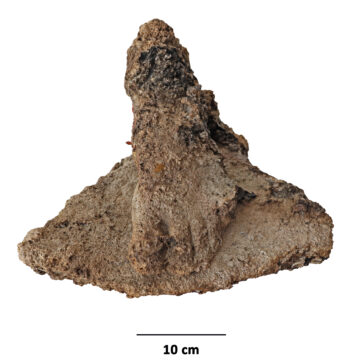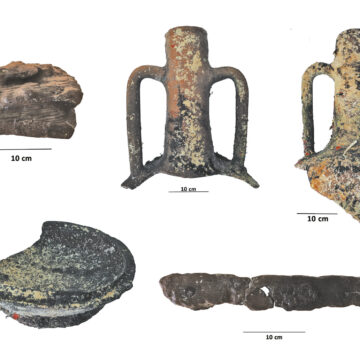Ancient Ship Remains Rescued from Antikythera Wreck
The 2025 excavation campaign on the Antikythera shipwreck, conducted from May 15 to June 12th, led to the recovery of several still-connected fragments of the ship’s hull. These elements will help answer key questions about ancient shipbuilding and offer unprecedented insights into navigation in the ancient Mediterranean
Delicate Recovery of Wooden Fragments
Special attention was given to retrieving three outer planks still joined to an internal frame, a rare set of articulated hull fragments that was discovered in 2024. This find, recovered intact in 2025 thanks to a specially designed support structure, represents an important technical achievement and provides valuable insight into ancient naval techniques. The assemblage confirms the use of the “shell-first” construction method, typical of the Mediterranean between the 4th and 1st centuries BCE, in which the outer shell is built before the internal structures.
Initial analysis indicates the wood is elm and oak, possibly dating to around 235 BCE. The fragment measures approximately 0.40 m wide and 0.70 m long. The planks, thinner than those discovered by Jacques-Yves Cousteau in 1976 (less than 5 cm), raise several questions: do they belong to the upper section of the ship, a repair, or a smaller accompanying vessel? A detailed study is underway to determine their nature. Other wooden fragments were also identified in situ, associated with both inorganic (lead, copper) and organic (tar) materials, near the area previously explored by Cousteau.
Sculpture Fragments
During the extraction of a rock, small fragments of a nude male statue standing in the contrapposto pose were discovered and documented in situ. Only a marble base, preserving the lower part of the statue’s left leg, could be clearly identified. More fragments remain trapped in hard marine concretions and could not be extracted at this stage.
Variety in the Amphora Cargo
The discovery of Chian amphorae, spread across two distinct zones of the wreck, indicates greater typological diversity than what previous campaigns had suggested. A spouted terracotta mortar, used for crushing and/or mixing food, was also found, offering rare insight into culinary practices aboard.
Advanced Technology and Scientific Documentation
As in 2024, the use of closed-circuit rebreathers with gas mixes optimized dive safety and duration. Operations were monitored in real time with underwater drones provided by Hublot Xplorations. A field lab was reinstalled on the island of Antikythera to allow for preliminary on-site analysis. The excavation was systematically documented via 3D photogrammetry, with data—drawings, photographs, surveys—integrated into a geographic information system (GIS). Enriched by data from previous campaigns, this body of material now serves as an essential basis for future research.
An International Scientific Collaboration
The 2021–2025 research program is led by the Swiss School of Archaeology in Greece (ESAG), under the supervision of the Ephorate of Underwater Antiquities οf the Greek Ministry of Culture.
The program is led by Dr. Angeliki G. Simosi (Honorary Curator of the Greek Ministry of Culture) and Professor Lorenz E. Baumer (University of Geneva). Fieldwork was supervised by Dr. Patrizia Birchler Emery (University of Geneva) and architect-diver Aikaterini Tagonidou. Athina Patsourou, technical diver, oversaw operations on behalf of the Ephorate. Alexandros Sotiriou (associate researcher, University of Geneva) coordinated the diving team. Specialized documentation was carried out by experts from the University of Geneva. Hublot Xplorations provided essential technical support. Yiannis Bitsakis (University of Geneva and Nereus Research Foundation) was in charge of organizing the mission.
Partners and sponsors
The research project “Return to Antikythera” is under the patronage of H.E. the President of the Hellenic Republic, Mrs. Katerina Sakellaropoulou.
The main sponsors of the research program are the Swiss watchmaker Hublot, the Aikaterini Laskaridis Foundation and the Nereus Research Foundation. The telecommunication services are provided by COSMOTE.
Photos & Press release
For more information, please contact:
Sylvie Fournier, Head of Communications
Swiss School of Archaeology in Greece
communication@esag.swiss
+41 78 890 04 20
Prof. Lorenz Baumer, Co-director of the Project
University of Geneva
Lorenz.baumer@unige.ch

